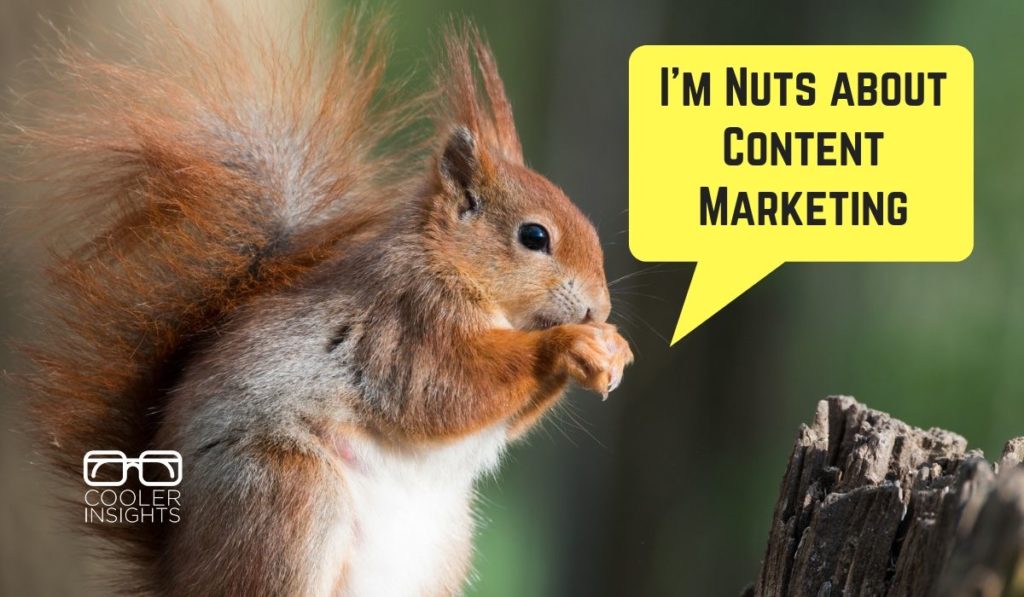
Is content marketing driving you nuts?
Well if it does, this article may be just the thing for you. Especially if you adore those cute furry little things that scurry up trees around your neighbourhood.
In case you don’t already know, the squirrel family is one of the most successful mammalian groups on our planet.
From tiny chipmunks (Chip & Dale anybody) to big prairie dogs, they can be found on almost every habitat on Earth. Apparently, there are almost 300 species of squirrels, and they can be found on virtually every continent.
While squirrels may not be as grand and noble as lions, or as majestic as eagles, they have thrived far better than many other animals due to their uncanny abilities to adapt to their environments.
So what content marketing strategy lessons can these cheeky furry-tailed rodents impart to us?
Let us dive right in.
#1 Specialise In Your Niche

Arctic Ground Squirrel (courtesy of Pixabay)
Squirrels are everywhere – from tropical rainforest canopies, the Arctic tundra, to the baking desert and cities around the world.
What’s unique about these furry nut-chomping rodents are their uncanny abilities to adapt to their environments.
Consider these facts:
- The Malabar giant squirrel which measures more than three feet in length can hang upside down while it feeds. It also has an unusually flexible ankle joint allowing its feet to rotate almost 180 degrees!
- Flying tree squirrels in SEA (including Singapore) can possibly glide up to 90 metres in distance – that’s almost the length of a century sprint track!
- A squirrel’s front teeth never stops growing – they do get a lot of wear and tear from relentless chomping.
- The Arctic ground squirrel can hibernate by reducing its heart rate, breathing and body temperature, surviving on stored fat alone.
While you may not be as acrobatic or arboreal like these furry rodents, you can follow their example by adapting to your specific content niche.
Consider your business environment, content marketing channels, and customer preferences. Pick and choose the right content types to suit different stages of your prospect’s buying journey. Ensure that you use the right cultural references and language to suit your customer’s preferences.
#2 Know Your Enemy

Via Giphy
Ever tried to catch a squirrel with your bare hands? And succeed?
(Well neither have I.)
Masters in the art of escape, squirrels are nimble, agile, and highly airborne. Their sense of sight, smell and movement are acutely attuned to predators like snakes, cats and eagles, allowing them to quickly dart out of danger.
Oh, and they’re also fiercely territorial animals, guarding their turf (or tree) from unwanted foreign squirrels viciously.
While the world of business may not be as “squirrel-eat-squirrel” as that of our furry friends, you should still deploy the right spying tools to sense your environment for dangers and opportunities. Here are three of my favourite tools that you can use:
- SimilarWeb: Use this free app to guesstimate the website traffic, search keywords, social media channels, and topics that your competitors are ranking for.
- SpyFu: Want to find out which websites are ranking for your prized keywords? Or the backlinks that they’ve managed to attract? Use this tool!
- SocialBakers: Do a side-by-side comparison of your Facebook and Instagram properties with your competitors. Then visit their social media accounts to get a sense of the types of posts which gain more traction and how you can “copy” them.
#3 Test Before You Invest
Squirrels are always making small tentative moves before lunging for the big morsel.
Surreptitious and stealthy (maybe even clandestine), they peek around corners and approach any ‘reward’ with caution, testing the ground prior to making the big leap.
As mostly tiny rodents, their very lives depends on their abilities to reduce bold risk taking measures which could get them eaten!
Like a squirrel, you should also test your different content concepts before going nuts over them. This could reduce your risk in any content marketing campaign while improving your odds.
Here are some ways you can do so:
- Poll your Facebook audiences to find out which content pieces they’ll appreciate better.
- Use SurveyMonkey to evaluate the topics that your audiences may find more utility in.
- Put a little money into boosting your social media posts (like $5 a day for 4 days) to see what the response is like before sinking in more budget.
- Use A/B testing functions on your social media platforms to ascertain the best audience segments, placements, and creatives for your campaign.
#4 Learn To Crack Tough Nuts
Problem solving is a given in the squirrel world. And they are uncannily good at faking it too!
Squirrels are extremely intelligent animals.
From burying bogus nuts (to trick predators), using their tails as a signaling device, to running in erratic paths (to throw predators off) and storing nuts and seeds at multiple locations to maintain their energy – squirrels are fantastic problem solvers.
While you may not have as many predators as a squirrel does, you’ll still need to solve various problems on your content marketing journey. Here are some of the most popular ways to troubleshoot any issues you may face:
- Google for Answers: Yes, it can be as simple as that, knowing how extensive the repository of knowledge online is – many of them free.
- Tap Expert Forums: There are tonnes of online forums focused on specific platforms and the challenges you may face. They include WordPress, Facebook’s Help Community, Google Help, SEO Forums… the possibilities are endless
- Watch a YouTube Video: Contrary to popular belief, YouTube isn’t just about cat and baby videos, or MTVs starring your favourite celebrities. If you use the right phrases, you may be able to find a solution to your content or technical challenges.
- Hire an Agency: Like Cooler Insights! OK, even if you don’t work with us, there are specialists in the different arms of content marketing whom you can work with.
#5 Seize Temporary Opportunities…

Via Giphy
Almost all squirrels are thieves. And they are not afraid of grabbing morsels of food from you in the slightest of moments.
I still remember a trip to Canada which my family did in 2011. While the scenery was breathtaking, and the bears were amazing, it was the little chipmunks which we had to be wary of.
These mischievous little rodents were always hovering around our picnic areas, looking for an opportunity to make off with a sandwich, salad or snack!
Like a squirrel, you should always be on the alert for content opportunities based on what’s hot and trending. Through newsjacking or trendjacking, you can roll out a piece of content which may catch your audience’s attention.
There are three tools you can use to determine what’s hot and trending:
- Google Trends: Find out what topics and keywords are trending in search patterns, so that you consider riding on them.
- Trends24: Use this tool to find out what people are tweeting about around the world, and see if you can create a piece of content to ride on this.
- Google Alerts: Set Google Alerts to keywords and topics that you’re interested in. When Google’s spiders come across them, they will email you with the latest content pieces revolving around those topics.
#6 …But Store For The Winter
https://www.youtube.com/watch?v=uWeU2s6JYyk
Squirrels bury their nuts in the ground, a behavior called caching. They dig up and eat most of the food they bury.
This behaviour allows them to hibernate through the winter, and to also survive during periods of famine or drought.
As a content strategist, you goal is to keep your content mill churning with articles, videos, infographics, short text posts, photos, and other content formats.
But what happens if your creativity grinds to a halt? Or your writers need to go on a prolonged leave?
The answer lies in rigorous content planning and content scheduling, ensuring that you have a sufficient pipeline of content assets to roll out.
Doing so helps you to improve your content productivity, build up a content bank, and ensure that you always have something to produce even when you don’t feel like it.
#7 Collaborate And Give Value
Finally, squirrels are great collaborators.
Ground squirrels like prairie dogs have been known to build entire underground towns, while tree squirrels often warn other squirrels of approaching enemies.
Tree squirrels may also bury extra nuts not only for themselves but for other squirrels.
I’ve often stated that while content may be king, community is queen. You can’t do content marketing isolated on an island.
Instead, you need to engage with the content of others by liking, commenting and sharing them, and to build your community of fans on social media.
The best content marketers are influencers who diligently apply the Robert Cialdini’s 6 Weapons of Influence to build their following (see below).

Courtesy of Ack Solutions
Conclusion
Tremendously successful across a wide variety of habitats, squirrels are the comics of the animal world. By applying a wide range of strategies, these modest-sized rodents are able to survive and thrive in both natural and urban environments through the ages.
Like the squirrel, content marketers need to be quick-witted, alert, flexible and agile. In a digital world that is constantly evolving and changing, only those who are paranoid will survive.
Like this article? Read my other article on Content Marketing Strategies featuring germs and bacteria!

Specialization In Niche is important. Thanks for the great tips for content marketing.
You have a great way to convey your message. I enjoyed reading your post